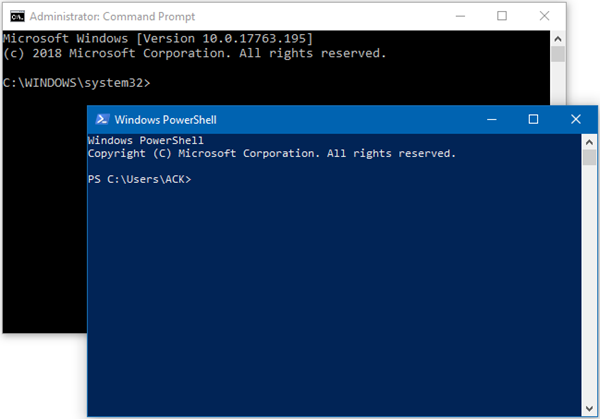Windows 11 and Windows 10 ships with Windows PowerShell out of the box. Along with it, came the Command Prompt which was a successor to MS-DOS Command line. Often the presence of two command-line tools in one operating system can confuse the user. Today, we will be discussing in brief what the difference between Command Prompt and Windows PowerShell is and which should you use when! This introductory post is targeted at the beginner or common end-user.
Command Prompt vs. Windows PowerShell

Before we discuss the differences, let’s first examine the brief histories of Command Prompt and Windows PowerShell.
The Windows Command Prompt command line is a simple Win32 application. It has the capability of interacting with any other Win32 application or object within the Windows operating system. People use it for various purposes – but mainly to toggle critical Windows settings and to fix various components of the Operating System, using tools like the System File Checker. It can also loosely be called an upgraded version of MS-DOS. MS-DOS was Microsoft’s Command Line application on Windows Operating Systems before the Command Prompt was introduced.
The Windows PowerShell command-line brings in deeper integration with the Windows Operating System and brings in support for scripting as well. It is based on the .NET Framework and was first released in 2006. It is used for all the tasks that the Command Prompt can execute – but additionally, it is a great tool for System Administrators as well.
The Real Difference
The initial difference lies in the fact that PowerShell leverages the use of what is known as cmdlets. These cmdlets allow the user to carry out a number of administrative tasks like managing the Registry to working with Windows Management Instrumentation. The Command Prompt cannot carry out such tasks.
If you have even slight exposure to computer programming, you will know about Variables. These variables are used to store data, which can be used for carrying out different operations. The PowerShell cmdlets can be used for operations in another cmdlet. This allows the fusion of several cmdlets to build a complex yet effective cmdlet that carries out a task once and for all. You may be able to relate this to Pipes in Linux.
Finally, Windows PowerShell ships with Windows PowerShell ISE which makes it a great scripting environment, which can be used to create and manage different PowerShell scripts that use the .ps1 extension.
The Windows Command Prompt cannot do all these things. It is a legacy environment that is being carried forward to newer Windows releases. It is inspired by MS-DOS, but does not have much access to administrative privileges, the way Windows PowerShell has.
When to use CMD
Use Command Prompt when running simple commands or batch files or working with legacy scripts and commands.
When to use PowerShell
Use PowerShell to automate tasks, manage configurations, or perform complex system administration tasks.
Conclusion
If you fire up some basic commands like ipconfig, netsh, sfc, etc. you can continue using the Windows Command Prompt. It is the command line that is made for the common user who needs some basic information or wants to run basic operations like Disk Error Checking or System File Checker.
But if you want to run complex operations or want to manage a remote computer or a server, you should be using Windows PowerShell, as it has various capabilities to carry out tasks like these. However, there might be a learning curve related to PowerShell – but it will be worth the effort.
Is there any reason to use CMD over PowerShell?
Yes – Using CMD over PowerShell is advantageous for running simple batch files and legacy scripts. CMD’s compatibility with older scripts makes it ideal for basic automation.
Read next:
Leave a Reply